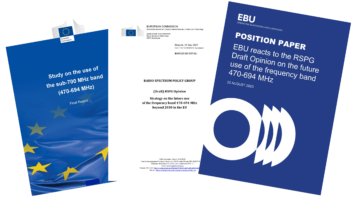
Photo by RadioDNS Chairman Nick Piggott during his return to England from Las Vegas. As Piggott explained on Flickr: “These photos were taken from a CO B757-200 en-route from EWR-BRS around 06:00 UTC on 15-APR, fly southerly of Iceland (these photos are taken looking towards Iceland from the northern side of the aircraft). The normal cloud layer is at the bottom, and usually the sky would be clear to the horizon. The wispy black line at the top looks like a vapour trail from a preceding aircraft, but much darker than usual, possibly from the ingestion of ash into the engine.” Some 27 percent of NAB Show attendees came from abroad this year, and more than a few of them are having their stay in Las Vegas or other parts of the United States extended thanks to the Eyjafjallajökull eruption.
Eyjafjallajökull, a glacier-covered volcano in southern Iceland, erupted on April 15 causing massive disruptions to air traffic across Northern Europe. As the ash plume spread, countries in the affected area began shutting down airspace, starting with the United Kingdom at noon British Summer Time on April 15; U.K. airspace is expected to be reopened at 1 p.m. BST on April 17, if the ash has sufficiently dispersed.
Airborne volcanic ash can clog jet engines to a point where they shut down. According to the International Airways Volcano Watch Operations Group, volcanic ash can damage jet turbine engines, abrade cockpit windows and airframes, clog pitot-static systems, penetrate air-conditioning and cooling systems, and contaminate fuel, hydraulic, electrical and smoke-detection systems.
IAVWOG recommendations bar planes from travelling through plumes for two to three days after an eruption; it assumed that if ash is visible in the air, either visually from the aircraft or via satellite, then it presents a hazard.
As of this morning (April 16), Belgium, the Czech Republic, Denmark, Estonia, Finland, France, Germany, Iceland, Latvia, Lithuania, Luxembourg, Netherlands, Norway, Poland, Ireland, Romania, Russia, Spain, Sweden and the United Kingdom had closed or restricted airspace, leading to flight delays across Europe.












